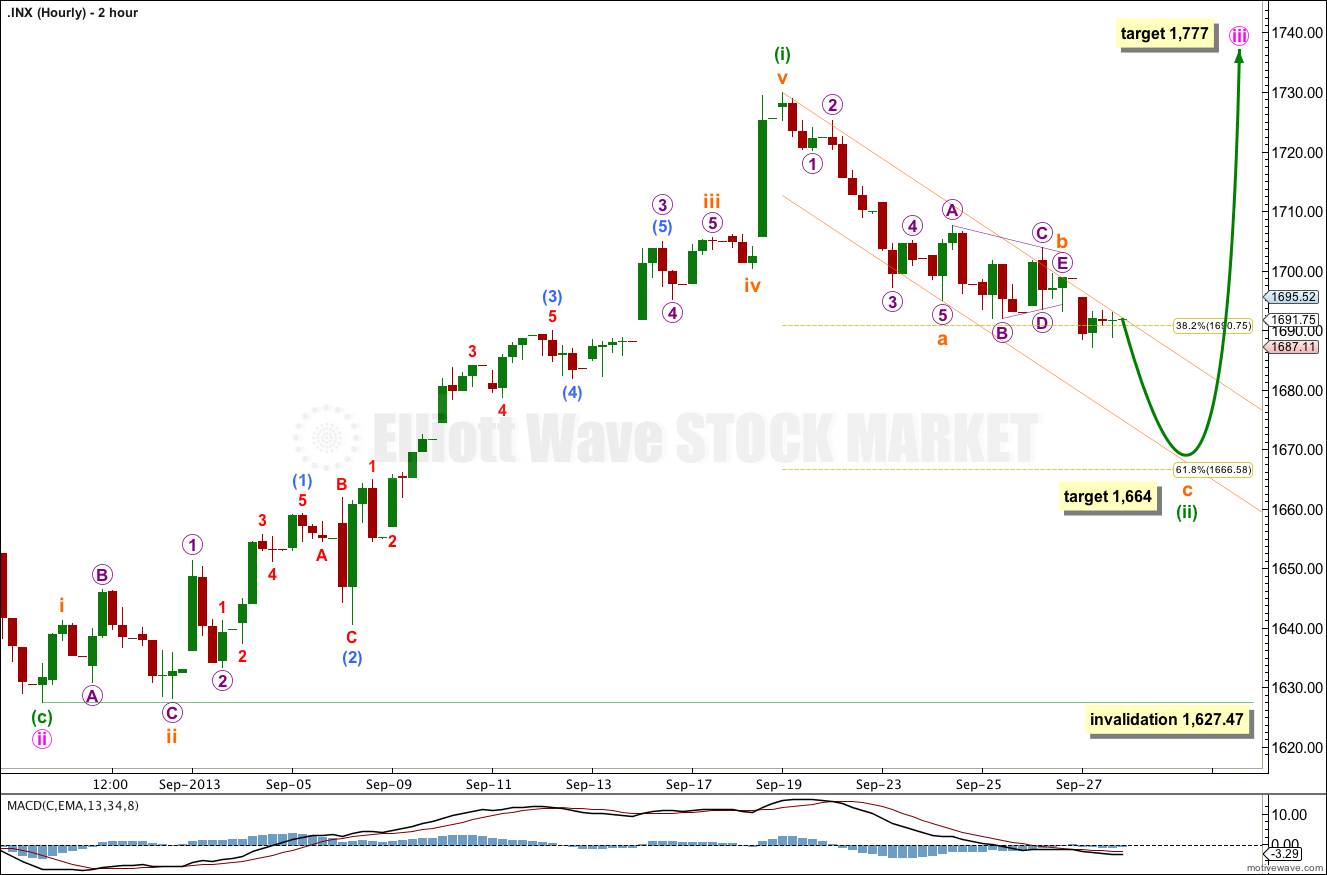I had expected upwards movement for Friday. Price moved lower and this has changed the wave count.
Although the wave count at the hourly chart level remained valid, it no longer had the “right look”.
Click on the charts below to enlarge.
At 1,740 intermediate wave (C) would reach equality with intermediate wave (A). At 1,739 minor wave 5 would reach 0.618 the length of minor wave 3.
If price rises through this first target the next target will be used. At 1,849 minor wave 5 would reach equality with minor wave 3.
When minute waves iii and iv within minor wave 5 are complete I will add to the target calculation at minute wave degree, so at that stage it may change.
Minor wave 1 lasted a Fibonacci 21 days, minor wave 2 lasted a Fibonacci 8 days, minor wave 3 has no Fibonacci duration at 98 days, and minor wave 4 lasted 22 days, just one day longer than a Fibonacci 21.
Minor wave 5 may not exhibit a Fibonacci time relationship. The next possibility may be the 29th of October (give or take two days either side of this date) where minor wave 5 would have lasted a Fibonacci 89 days. This is a date to look out for, but cannot be relied upon because Fibonacci time relationships do not occur often enough to be reliable.
Keep drawing the wider parallel channels from the monthly chart and copy them over to the daily chart.
*The data for the daily chart is now missing two daily candlesticks. I am aware of this and am looking for a new data feed.
The downwards movement for last week is most likely a correction at the same degree as the prior wave up; that is, it is not a correction within the upwards wave but instead it is correcting that upwards wave.
We may have seen minuette wave (i) complete, and now minuette wave (ii) nearing completion.
At 1,664 subminuette wave c would reach equality in length with subminuette wave a. This would bring minuette wave (ii) to just below the 0.618 Fibonacci ratio of minuette wave (i).
Ratios within minuette wave (i) are: subminuette wave iii has no Fibonacci ratio to subminuette wave i, and subminuette wave v is just 0.08 points shorter than 0.382 the length of subminuette wave iii.
Ratios within subminuette wave iii are: micro wave 3 has no Fibonacci ratio to micro wave 1, and micro wave 5 is just 0.07 points short of 0.146 the length of micro wave 3.
Ratios within micro wave 3 are: submicro wave (3) has no Fibonacci ratio to submicro wave (1), and submicro wave (5) is 2.77 points short of equality with submicro wave (1).
Ratios within submicro wave (3) are: minuscule wave 3 has no Fibonacci ratio to minuscule wave 1, and minuscule wave 5 is 0.86 points longer than 0.382 the length of minuscule wave 1.
Draw a parallel channel about minuette wave (ii). While price remains within the channel I will expect more downwards movement. When this channel is clearly breached then the correction should be over and I will expect upwards movement towards the target.
Minuette wave (ii) may not move beyond the start of minuette wave (i). This wave count is invalidated with movement below 1,627.47.
Alternate Daily Wave Count.
There are two structural possibilities for minor wave 5. The main wave count looks at the most likely structure of an impulse. This alternate will consider the less likely possibility of an ending diagonal.
The ending diagonal may be contracting. All the subwaves must subdivide into zigzags, and the fourth wave must overlap back into first wave price territory.
Minute wave i may be recently completed. Downwards movement may be the start of minute wave ii.
Second waves within diagonals are commonly between 0.66 to 0.81 the length of the first wave. This gives us a target zone between 1,618 and 1,593. I would expect downwards movement to find support at the lower edge of the blue parallel channel (or slightly above this line).
Minute wave ii may not move beyond the start of minute wave i. This wave count is invalidated with movement below 1,560.33.



